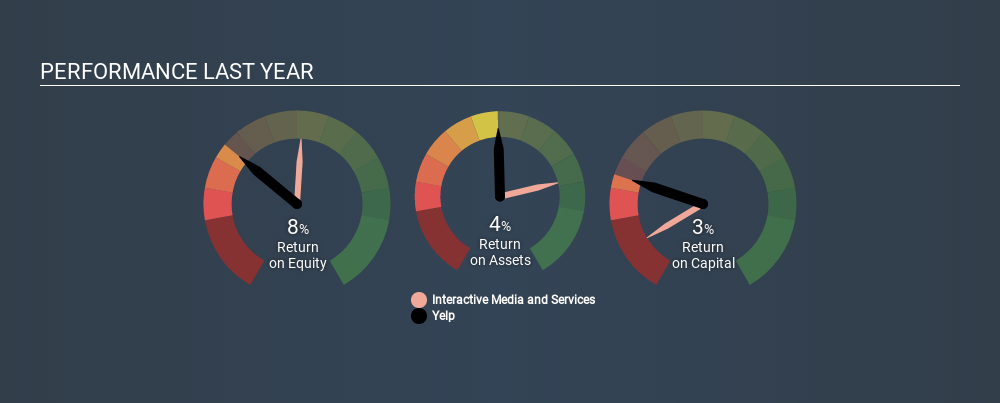- United States
- /
- Interactive Media and Services
- /
- NYSE:YELP
How Do Yelp Inc.’s (NYSE:YELP) Returns On Capital Compare To Peers?

Today we'll evaluate Yelp Inc. (NYSE:YELP) to determine whether it could have potential as an investment idea. Specifically, we'll consider its Return On Capital Employed (ROCE), since that will give us an insight into how efficiently the business can generate profits from the capital it requires.
First, we'll go over how we calculate ROCE. Then we'll compare its ROCE to similar companies. Last but not least, we'll look at what impact its current liabilities have on its ROCE.
What is Return On Capital Employed (ROCE)?
ROCE measures the 'return' (pre-tax profit) a company generates from capital employed in its business. All else being equal, a better business will have a higher ROCE. Ultimately, it is a useful but imperfect metric. Author Edwin Whiting says to be careful when comparing the ROCE of different businesses, since 'No two businesses are exactly alike.
How Do You Calculate Return On Capital Employed?
The formula for calculating the return on capital employed is:
Return on Capital Employed = Earnings Before Interest and Tax (EBIT) ÷ (Total Assets - Current Liabilities)
Or for Yelp:
0.034 = US$31m ÷ (US$1.0b - US$136m) (Based on the trailing twelve months to September 2019.)
So, Yelp has an ROCE of 3.4%.
Check out our latest analysis for Yelp
Does Yelp Have A Good ROCE?
ROCE can be useful when making comparisons, such as between similar companies. In this analysis, Yelp's ROCE appears meaningfully below the 9.1% average reported by the Interactive Media and Services industry. This performance could be negative if sustained, as it suggests the business may underperform its industry. Regardless of how Yelp stacks up against its industry, its ROCE in absolute terms is quite low (especially compared to a bank account). There are potentially more appealing investments elsewhere.
Yelp has an ROCE of 3.4%, but it didn't have an ROCE 3 years ago, since it was unprofitable. That suggests the business has returned to profitability. The image below shows how Yelp's ROCE compares to its industry, and you can click it to see more detail on its past growth.

When considering this metric, keep in mind that it is backwards looking, and not necessarily predictive. ROCE can be deceptive for cyclical businesses, as returns can look incredible in boom times, and terribly low in downturns. This is because ROCE only looks at one year, instead of considering returns across a whole cycle. Since the future is so important for investors, you should check out our free report on analyst forecasts for Yelp.
Yelp's Current Liabilities And Their Impact On Its ROCE
Current liabilities are short term bills and invoices that need to be paid in 12 months or less. Due to the way the ROCE equation works, having large bills due in the near term can make it look as though a company has less capital employed, and thus a higher ROCE than usual. To check the impact of this, we calculate if a company has high current liabilities relative to its total assets.
Yelp has total liabilities of US$136m and total assets of US$1.0b. Therefore its current liabilities are equivalent to approximately 13% of its total assets. This is a modest level of current liabilities, which will have a limited impact on the ROCE.
What We Can Learn From Yelp's ROCE
Yelp has a poor ROCE, and there may be better investment prospects out there. You might be able to find a better investment than Yelp. If you want a selection of possible winners, check out this free list of interesting companies that trade on a P/E below 20 (but have proven they can grow earnings).
If you like to buy stocks alongside management, then you might just love this free list of companies. (Hint: insiders have been buying them).
If you spot an error that warrants correction, please contact the editor at editorial-team@simplywallst.com. This article by Simply Wall St is general in nature. It does not constitute a recommendation to buy or sell any stock, and does not take account of your objectives, or your financial situation. Simply Wall St has no position in the stocks mentioned.
We aim to bring you long-term focused research analysis driven by fundamental data. Note that our analysis may not factor in the latest price-sensitive company announcements or qualitative material. Thank you for reading.
About NYSE:YELP
Yelp
Operates a platform that connects consumers with local businesses in the United States and internationally.
Flawless balance sheet with proven track record.
Similar Companies
Market Insights
Community Narratives



